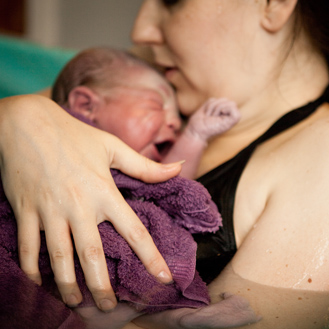
February 20, 2023
By Yinny Chan, Drexel University College of Medicine
Water births are when labor and/or delivery occurs in a warm body of water, usually a birthing tub or pool. The earliest account of a water birth was in 1805, in which a woman had been laboring for hours and went for a bath for the purpose of relaxation. She then gave birth into the water and the baby survived. The attraction to choosing this form of delivery comes from the belief that water births provide pain relief and stress reduction for the mother and offer an easier transition for the baby from amniotic fluid to water. What are the proven benefits of water births, and are there risks?
Benefits
Pain Relief
Water-assisted labor has often been referenced to as “aquadural,” as some studies have shown that women who labor in water request epidurals less often. Lower rates of anlagesic use in water births versus land births were shown in a nine-year observational study (Geissbuehler et al., 2004). However, it is unclear whether these lower rates are due to the specific preferences of women who choose to use an alternative birthing method.
Risks
Water Aspiration
Water aspiration is a common concern for water births. However, some clinicians argue that babies do not ingest water due to the diving reflex. When a baby is submerged in water, there is a natural parasympathetic response in which the baby holds their breath. However, this reflex is not always reliable, and aspiration can lead to electrolyte imbalance or infection.
Neonatal and Maternal Infection
Contaminated water is a major concern with water birth. The source of the water and the potential of fecal matter from the mother can be risks. However, the evidence supporting this risk has been variable. A pediatric epidemiology study of 4,032 water births found that two infants were reported to have an infection (Gilbert & Tookey,1999). There have also been case reports of neonatal infection after water birth. In one case, the newborn had been diagnosed with Pseudomonas 12 hours after birth (Parker & Boles, 1997). In another case, the newborn was diagnosed with Legionella 26 days after birth (Franzin et al., 2001). It was later discovered that the water used to fill the pool was infected with Legionella as well. In contrast, the Cochrane Database of Systematic Review, which included two randomized controlled trials, indicated that water births are not associated with increased neonatal infection rates.
Conclusion
While there are conflicting bodies of evidence on the benefits and risks of water births, the American College of Obstetricians and Gynecologists currently recommends that a “water birth may be offered to healthy women with uncomplicated pregnancies between 37 and 41 weeks.” The way someone decides to labor or give birth is an individual choice. However, should a patient opt for a water birth, their obstetrician should inform them of the potential benefits and risks.
Sources/Resources:
- Geissbuehler V, Stein S, Eberhard J. Waterbirths compared with landbirths: an observational study of nine years. J Perinat Med. 2004;32(4):308-14. doi: 10.1515/JPM.2004.057. PMID: 15346814
- Cluett ER, Burns E, Cuthbert A. Immersion in water during labour and birth. Cochrane Database of Systematic Reviews 2018, Issue 5. Art. No.: CD000111. DOI: 10.1002/14651858.CD000111.pub4
- Gilbert RE, Tookey PA. Perinatal mortality and morbidity among babies delivered in water: surveillance study and postal survey. BMJ. 1999 Aug 21;319(7208):483-7. doi: 10.1136/bmj.319.7208.483. PMID: 10454400; PMCID: PMC28200
- Parker PC, Boles RG. Pseudomonas otitis media and bacteremia following a water birth. Pediatrics. 1997 Apr;99(4):653. doi: 10.1542/peds.99.4.653a. PMID: 9093328
- Franzin L, Scolfaro C, Cabodi D, Valera M, Tovo PA. Legionella pneumophila Pneumonia in a Newborn after Water Birth: A New Mode of Transmission. Clinical Infectious Diseases, Volume 33, Issue 9, 1 November 2001, Pages e103–e104, https://doi.org/10.1086/323023